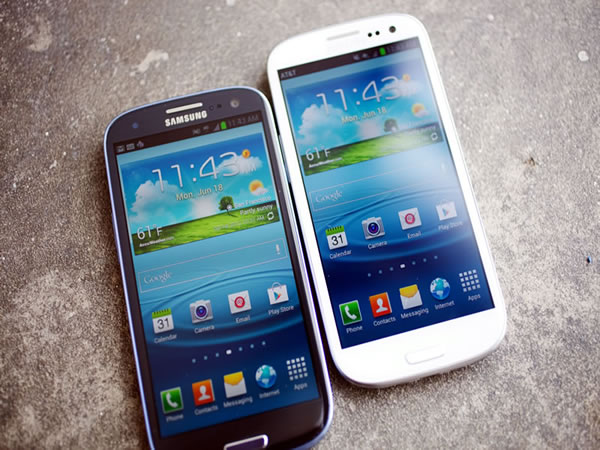
Buoyed by the Galaxy S III smartphone and the Galaxy Note II “Phablet” and sales of flatscreens to all manner of companies — including their rival, Apple — Samsung made over $8 billion in profit during the most recent quarter. They’ve managed to move almost 500 handsets a minute, selling about 15 million Galaxy S IIIs and another 8 million Galaxy Note IIs.
Neil Mawston, executive director at market researcher Strategy Analytics, said that his firm predicts that Samsung will sell 290 million smartphones this year, up from a projected 215 million for 2012. Kiwoom Securities’ analyst, Kim Sung-in, has an even bigger estimate: he predicts Samsung shipping 320 million smartphones in 2013, with tablet sales doubling to 32 million.

The latest numbers for ComScore’s MobiLens numbers have come in. For November 2012 in the U.S., they say that Android had 53.7% of the market share followed by iOS, with 35.0%. Combined, that’s nearly 90% of the U.S. mobile market: a Google/Apple duopoly.
Here’s a table based on ComScore’s latest data showing U.S. mobile market share by vendor:
| Smartphone Vendor | Aug 2012 Share | Nov 2012 Share | Change |
|---|---|---|---|
| 52.6% | 53.7% | +1.1% | |
| Apple | 34.3% | 35.0% | +0.7% |
| RIM | 8.3% | 7.3% | -1.0% |
| Microsoft | 3.6% | 3.0% | -0.6% |
| Symbian | 0.7% | 0.5% | -0.2% |
Recovering Windows Phone Champ that I am, it pains me to see that Microsoft’s share has dropped from 3.6% to 3.0% (it also relieves me that I’m no longer involved with that train wreck). It’s a far cry from Gartner’s predictions — and yes, I’m going to keep pointing back to them from time to time: they said that by now, they expected Windows Phone to have made off with nearly 11% of the market.

With the increasing abandonment of BlackBerry devices and the Galaxy S III passing security muster at a number of corporations, Samsung is reportedly making big pushes into the enterprise market for 2013. According to Reuters, SAP has standardized around the Galaxy S III, Galaxy Note and Galaxy Tab devices. SAP’s CIO says that “the one clear trend in enterprise is the shift away from one device to multiple devices” and “because of the fragmentation of the Android software, we decided to go with just one Android company and we went with Samsung”.

On the more personal side, reports of Apple fans taking up Android devices and enjoying them continue to pop up. I myself picked up a Galaxy S III a month ago and have made it my primary phone for the time being. It’s quite enjoyable, and I have yet to find an app that’s iPhone-only that I miss. I’m enjoying my stay in Android-land.
A notable convert is mobile app developer Grandcentrix’ CEO Ralf Rottmann. He was a die-hard Apple fan, but in a popular article on Gizmodo titled An iPhone Lover’s Confession: I Switched to the Nexus 4. Completely., he writes that he’s fallen in love with Android:
I find it to be better in terms of the performance, smoothness of the rendering engine, cross-app and OS level integration, innovation across the board, look & feel customizability and variety of the available apps.
This article also appears in Mobilize!: The CTS Mobile Tech Blog.
2 replies on “Samsung and Android News Roundup”
[…] As I wrote in an earlier article, Samsung’s mobile division have been chasing after the enterprise market. Opportunities abound in the enterprise for the Apple/Samsung duopoly, what with the mass exodus from BlackBerry and a complete lack of interest in Windows Phone, despite their business-friendly features. In their pursuit of enterprise customers, they’ve been doing their homework and finding out what people at enterprises want in their BYOD programs, and their findings are summarized in the infographic above. […]
[…] As I wrote in an earlier article, Samsung’s mobile division have been chasing after the enterprise market. Opportunities abound in the enterprise for the Apple/Samsung duopoly, what with the mass exodus from BlackBerry and a complete lack of interest in Windows Phone, despite their business-friendly features. In their pursuit of enterprise customers, they’ve been doing their homework and finding out what people at enterprises want in their BYOD programs, and their findings are summarized in the infographic above. […]